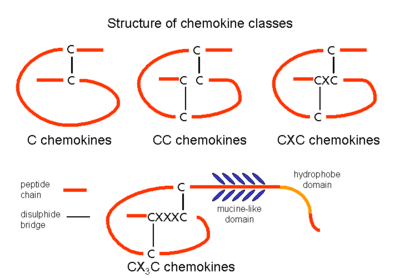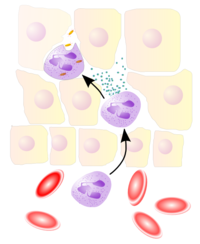Reviewer: S. Randhawa, M.D., Allergist/Immunologist and Assistant Professor at NSU
What is a chemokine?
Chemokines are a family of small cytokines (proteins) secreted by cells. All chemokines share similar characteristics such as small size (8-10 kilodaltons in size), and the presence of 4 cysteine residues that are key to forming their 3-dimensional shape. Their name is derived from their ability to induce directed chemotaxis in nearby responsive cells; they are chemotactic cytokines.
Classification
More than 50 chemokines interacting with 20 receptors have been described (52 chemokines as of 2010).
The chemokine receptors are part of the G-protein coupled receptors (7-membrane domain, snake-like structures).
The position of cysteine residues (C) in the chain subdivides chemokines into 4 structural families.
Members of the chemokine family are categorized into 4 groups depending on the spacing of their first 2 cysteine residues:
- C chemokines (2 members)
- CC chemokines (31 members)
- CXC chemokines (18 members)
- CX3C chemokines (1 member)

Chemokine structures. Image source: Wikipedia, GNU Free Documentation License.

All chemokines share a typical key structure that is stabilized by disulfide bonds between cysteine residues. Image source: Wikipedia, GNU Free Documentation License.

52 chemokines from 4 families have been described. They interact with 20 receptors (click here for a larger image).
Members of the chemokine family are categorized into 4 groups depending on the spacing of their first 2 cysteine residues:
- C chemokines (2 members)
- CC chemokines (31 members)
- CXC chemokines (18 members)
- CX3C chemokines (1 member)

Chemokine structures. Image source: Wikipedia, GNU Free Documentation License.

All chemokines share a typical key structure that is stabilized by disulfide bonds between cysteine residues. Image source: Wikipedia, GNU Free Documentation License.
52 chemokines from 4 families have been described. They interact with 20 receptors (click here for a larger image).
C chemokines
C chemokines (γ chemokines) are unlike all other chemokines in that they have only two cysteines; one N-terminal cysteine and one cysteine downstream. Only 2 chemokines have been described for this subgroup and are called XCL1 (lymphotactin-α) and XCL2 (lymphotactin-ß). These chemokines attract T cell precursors to the thymus.
CC chemokines
The CC chemokines (ß-chemokines) have two adjacent cysteines near their amino terminus. This is the largest group with 31 members.
CCL5 (or RANTES) attracts cells such as T cells, eosinophils and basophils that express the receptor CCR5.
HIV (syncitia-inducing (SI) strains) uses the chemokine receptor CXCR4 to enter CD4 T-cells.
CCR5
CXCR4 (CD4)
F
Five - CCR5
Four - CXCR4 (CD4) - also involved in WHIM syndrome (PIDD)
Foray of HIV into the CD4 T-cells
CCL5 or RANTES - HIV-suppressive factor released from CD8+ T cells
A mutation of CXCR4 causes a phagocytic defect called WHIM syndrome (Warts, Hypogammaglobulinemia, Infection, and Myelokathexis). Myelokathexis refers to retention (kathexis) of neutrophils in the bone marrow (myelo). Myelokathexis causes severe chronic leukopenia and neutropenia. CXCR4 antagonist plerixafor corrects panleukopenia in patients with WHIM syndrome (http://goo.gl/Xxbyt).
F
Five - CCL5
Fights HIV
CCL17 and CCL22
CCL17 and CCL22 both use the CCR4 receptor and are related to inflammation. Chemokine (C-C motif) ligand 17 is considered a new asthma biomarker.
CCL19 and CCL21
CCL19 and CCL21 together organize B and T cell areas of secondary lymphoid organs (lymph nodes) and aid in the recruitment and interaction of lymphocytes and APCs. CCL21 is strongly expressed on high endothelial venules (HEVs). HEVs are found in all secondary lymphoid organs, with the exception of spleen.
CCL11 is eotaxin.
CXC chemokines
The two N-terminal cysteines of CXC chemokines (α-chemokines) are separated by one amino acid, represented in this name with an "X". There are 18 CXC chemokines.
CXC chemokines are subdivided into 2 categories:
- those with a specific amino acid sequence (or motif) of glutamic acid-leucine-arginine (or ELR for short) immediately before the first cysteine of the CXC motif (ELR-positive)
- those without an ELR motif (ELR-negative)
ELR-positive CXC chemokines induce the migration of neutrophils, and interact with chemokine receptors CXCR1 and CXCR2. An example of an ELR-positive CXC chemokine is interleukin-8 (IL-8), which induces neutrophils (PMN) to leave the bloodstream and enter into the surrounding tissue.
Mnemonic:
P
Positive ELR (glutamic acid-leucine-arginine) chemokine CXC
PMN migration

Interleukin-8, a chemokine of the CXC subfamily. CXCL8 (IL-8) forms a chemotactic gradient that directs leukocytes (mostly PMNs) towards site of tissue injury/infection. Image source: Wikipedia, public domain.

Neutrophils extravasate from blood vessels to the site of tissue injury or infection during the innate immune response. Image source: Wikipedia, GNU Free Documentation License.
ELR-positive CXC chemokines induce the migration of neutrophils, and interact with chemokine receptors CXCR1 and CXCR2. An example of an ELR-positive CXC chemokine is interleukin-8 (IL-8), which induces neutrophils (PMN) to leave the bloodstream and enter into the surrounding tissue.
Mnemonic:
P
Positive ELR (glutamic acid-leucine-arginine) chemokine CXC
PMN migration

Interleukin-8, a chemokine of the CXC subfamily. CXCL8 (IL-8) forms a chemotactic gradient that directs leukocytes (mostly PMNs) towards site of tissue injury/infection. Image source: Wikipedia, public domain.

Neutrophils extravasate from blood vessels to the site of tissue injury or infection during the innate immune response. Image source: Wikipedia, GNU Free Documentation License.
CXC chemokines dominate neutrophil recruitment through binding to receptor CXCR2
CXCL1 binds to CXCR2
CXCL2 binds to CXCR2
CXCL3 binds to CXCR2
CXCL5 binds to CXCR2
CXCL6 binds to CXCR1 and CXCR2
CXCL7 binds to CXCR2
CXCL8 (IL-8) binds to CXCR1 and CXCR2
Chemokines that guide T and B cell migration within lymph nodes
CXCL13 (BCA-1) - binds to CXCR5 - causes B cell migration into follicles
CCL19 (MIP-3β/ELC) and CCL21 (SLC) - both bind to CCR7 - cause T cell and dendritic cell migration into parafollicular zones of lymph nodes
CD markers for central vs. effector memory T cells:
Central memory T cells: CD45RA-, CD27+, CCR7+, CD62L+
Effector memory T cells: CD45RA-, CD27-, CCR7-, CD62L-
Mnemonic
CXCL13 binds to CXCR5 - causes B cell migration into follicles
1 + 3 = 4, 5 (binds to CXCR5)
CCL19 and CCL21 bind to CCR7 - cause T cell cell migration into parafollicular zones of lymph nodes
9 - 2 = 7 (bind to CCR7)
There is only one CX3C chemokine - it has 3 amino acids between the 2 cysteines (d-chemokine). The only CX3C chemokine discovered to date is called fractalkine (or CX3CL1). It serves as both a chemoattractant and as an adhesion molecule.
Chemokine/receptor defects and diseases
CCR5/CCL3L1, CXCR4
HIV/AIDS
DARC
P. vivax malaria
CXCR4
HIV/AIDS
WHIM’s syndrome
CXCL4
Heparin-induced thrombocytopenia
CX3CR1, CCL5
Atheroslcerosis
CCL2, 5, 7, 11, CXCL8
Asthma/Allergies
CXCL12/CXCR4
Cancer metastases
(Click to enlarge the image).
Chemokine Signaling. This video describes the process of chemokine signaling. This video is from: Janeway's Immunobiology, 7th Edition, Murphy, Travers, & Walport. Source: Garland Science.
What is the most potent chemokine (chemoattractant) for eosinophils?
(A) IL-5
(B) IL-8
(C) LTB4
(D) eotaxin
(E) IL-4
(F) IL-13
Answer: D.
Eosinophil chemotactic protein 2 (Eotaxin-2) is the most potent chemoattractant for eosinophils but IL-5 is the most specific stimulant of their production.
There is more than one eotaxin:
CCL11 - Eotaxin
CCL24 - Eotaxin-2
CCL26 - Eotaxin-3
All of them bind to CCR3 - recruit eosinophils, basophils, and TH2 cells.
What chemokine attracts naïve B cells to lymph nodes?
CXCR5. CXCL13 binds to CXCR5.
What chemokine attracts naïve T cells to lymph nodes?
CCR7. CCL19 and CCL21 bind to CCR7.
Chemokine, Wikipedia.
(This article is based in large part on Wikipedia articles that were reviewed for accuracy, please see the reference links).
Mnemonics: Human immunodeficiency virus (HIV)
New biomarkers in asthma: chemokines and chitinase-like proteins
CX3CL1 (fractalkine) in allergic diseases: not just a chemotactic molecule http://goo.gl/eRqRm
Published: 05/18/2009
Updated: 06/20/2012
Mnemonics: Human immunodeficiency virus (HIV)
New biomarkers in asthma: chemokines and chitinase-like proteins
CX3CL1 (fractalkine) in allergic diseases: not just a chemotactic molecule http://goo.gl/eRqRm
Published: 05/18/2009
Updated: 06/20/2012
No comments:
Post a Comment